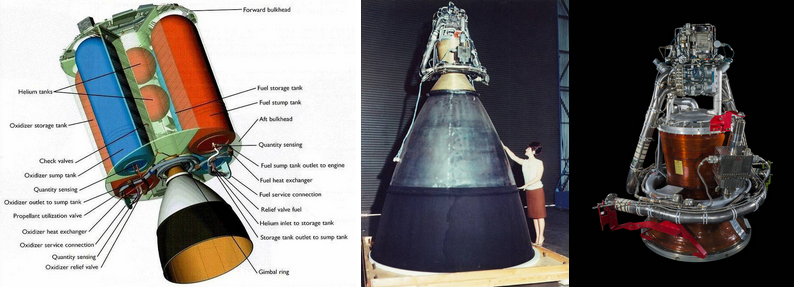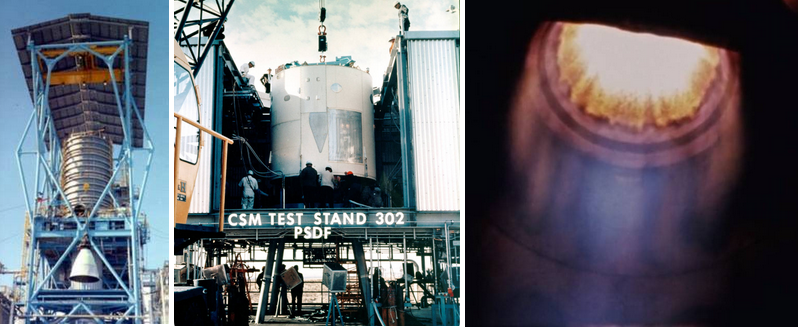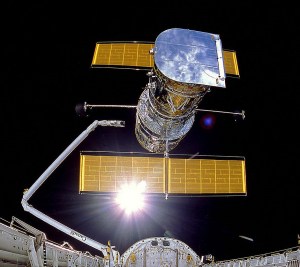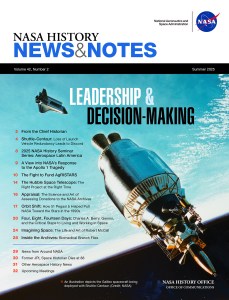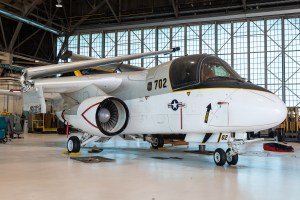In 1961, President John F. Kennedy committed the United States to landing a man on the Moon and returning him safely to the Earth. The Apollo Service Propulsion System (SPS) played a major role in achieving that objective. After NASA selected the lunar orbit rendezvous scenario for the Moon landing, the SPS engine provided the needed velocity change for the spacecraft to enter lunar orbit and, following completion of the landing, leave lunar orbit for the return trip to Earth. Secondarily, the SPS could make mid-course maneuvers. Engineers carried out a robust ground and spaceflight test program to ensure the reliability of the SPS and the safety of the astronauts. The first ground-based test firing of an SPS engine took place on June 26, 1963, followed by years of extensive ground and spaceflight testing before the first crewed mission, Apollo 7, in October 1968 fully tested the system in orbit.
In March 1962, NASA selected Aerojet-General’s Space Propulsion Division in Azusa, California, as the subcontractor to design, build, and test the SPS engine, designated AJ10-137, at a time when the agency favored the direct ascent mode to reach the Moon. The design of the SPS ensured that it had sufficient thrust to lift the entire Apollo spacecraft from the lunar surface for the direct trip back to Earth. Even after NASA selected lunar-orbit rendezvous in July 1962, no longer requiring such a powerful engine, managers decided not to change the design for the SPS so as not to delay its development. To increase the reliability of the engine now needed for critical maneuvers, especially the trans-Earth injection burn to bring the astronauts home, NASA chose the use of Aerozine 50 as fuel and nitrogen tetroxide as oxidizer. As hypergolic propellants, meaning they ignited upon contact with each other, they did not require a complex ignition system and also had the advantage of long-term storability. The engine generated 20,500 pounds of thrust and the gimbalable engine nozzle allowed precise steering.
Aerojet shipped the first fireable AJ10-137 SPS test engine (SN 003) to the Arnold Engineering and Development Center (AEDC) in Tullahoma, Tennessee, in May 1963 to begin the ground testing program, shipping two more engines in September and November. The first simulated-altitude SPS test fire took place on June 26, 1963. The engine firing of approximately 5 seconds resulted in a shutdown due to the collapse of the titanium nozzle extension from excessive back pressure in the test cell. Aerojet carried out sea-level test firings at its Sacramento, California, facility, and simulated-altitude test firings at AEDC on the Block I engine configuration used in the early uncrewed Apollo test flights between June 1963 and February 1967. For the Block II engines used on all crewed Apollo missions, Aerojet carried out sea-level and simulated altitude tests between April 1966 and September 1968. Engineers carried out further tests with a simulated Service Module at NASA’s White Sands Test Facility in Las Cruces, New Mexico, between November 1966 and April 1969. Engineers made numerous configuration changes throughout the engine development and qualification program based on knowledge accumulated during the tests.
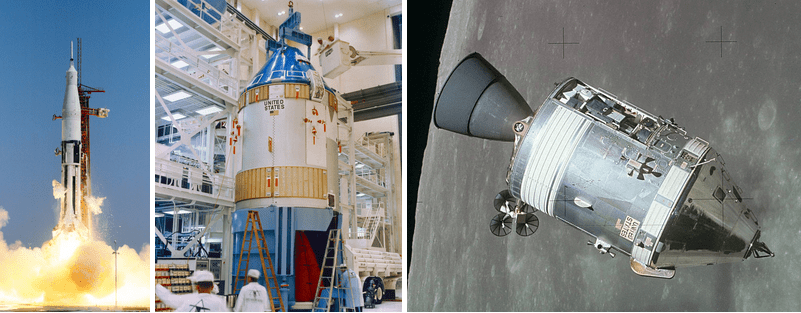
Before the first flight of the SPS on the AS-201 mission, engineers test fired it at Launch Pad 16 at NASA’s Kennedy Space Center in Florida in November 1965. During the flight itself on Feb. 26, 1966, the SPS achieved only 30 percent of its intended thrust during the 104-second firing due to ingestion of helium gas, with the same result during the second 10-second firing to test its restart capability. During the second flight, AS-202 on Aug. 25, 1966, the SPS performed well on all its four firings, meeting all test objectives, as it did on the Apollo 4 and 6 missions, on Nov. 9, 1967, and April 4, 1968, respectively. On the latter, due to the failure of the Saturn V’s third stage to restart, the SPS took over that function to send the Apollo spacecraft on its high-altitude trajectory. On the first flight of the SPS on a crewed mission, Apollo 7 in October 1968, the astronauts successfully fired it on eight occasions, and it performed without a hitch. By the time Apollo 8 flew to the Moon in December 1968, and the SPS engine had to start to first get them into lunar orbit and then to get them out to send them home to Earth, engineers had test fired it more than 3,200 times, and it had proven itself during actual space missions, giving NASA managers the confidence that it would work. And it did. And not only on that historic mission to orbit the Moon, but on all subsequent Apollo missions, the three flights to the Skylab space station, and on its last journey into space, the 1975 Apollo-Soyuz Test Project.


























